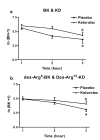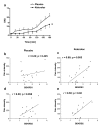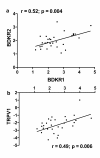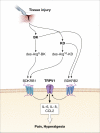Kinin B1 receptors contributes to acute pain following minor surgery in humans
- PMID: 20152050
- PMCID: PMC2834653
- DOI: 10.1186/1744-8069-6-12
Kinin B1 receptors contributes to acute pain following minor surgery in humans
Abstract
Background: Kinins play an important role in regulation of pain and hyperalgesia after tissue injury and inflammation by activating two types of G-protein-coupled receptors, the kinin B1 and B2 receptors. It is generally accepted that the B2 receptor is constitutively expressed, whereas the B1 receptor is induced in response to inflammation. However, little is known about the regulatory effects of kinin receptors on the onset of acute inflammation and inflammatory pain in humans. The present study investigated the changes in gene expression of kinin receptors and the levels of their endogenous ligands at an early time point following tissue injury and their relation to clinical pain, as well as the effect of COX-inhibition on their expression levels.
Results: Tissue injury resulted in a significant up-regulation in the gene expression of B1 and B2 receptors at 3 hours post-surgery, the onset of acute inflammatory pain. Interestingly, the up-regulation in the gene expression of B1 and B2 receptors was positively correlated to pain intensity only after ketorolac treatment, signifying an interaction between prostaglandins and kinins in the inflammatory pain process. Further, the gene expression of both B1 and B2 receptors were correlated. Following tissue injury, B1 ligands des-Arg9-BK and des-Arg10-KD were significantly lower at the third hour compared to the first 2 hours in both the placebo and the ketorolac treatment groups but did not differ significantly between groups. Tissue injury also resulted in the down-regulation of TRPV1 gene expression at 3 hours post-surgery with no significant effect by ketorolac treatment. Interestingly, the change in gene expression of TRPV1 was correlated to the change in gene expression of B1 receptor but not B2 receptor.
Conclusions: These results provide evidence at the transcriptional level in a clinical model of tissue injury that up-regulation of kinin receptors are involved in the development of the early phase of inflammation and inflammatory pain. The up-regulation of B1 receptors may contribute to acute inflammatory pain through TRPV1 activation.
Figures




Similar articles
-
Tibial post fracture pain is reduced in kinin receptors deficient mice and blunted by kinin receptor antagonists.J Transl Med. 2019 Oct 22;17(1):346. doi: 10.1186/s12967-019-2095-9. J Transl Med. 2019. PMID: 31640792 Free PMC article.
-
Pharmacological and molecular evidence for kinin B1 receptor expression in urinary bladder of cyclophosphamide-treated rats.Br J Pharmacol. 1999 Sep;128(1):213-9. doi: 10.1038/sj.bjp.0702769. Br J Pharmacol. 1999. PMID: 10498854 Free PMC article.
-
The synthesis and distribution of the kinin B1 and B2 receptors are modified in the hippocampus of rats submitted to pilocarpine model of epilepsy.Brain Res. 2004 Apr 23;1006(1):114-25. doi: 10.1016/j.brainres.2003.12.050. Brain Res. 2004. PMID: 15047030
-
International union of pharmacology. XLV. Classification of the kinin receptor family: from molecular mechanisms to pathophysiological consequences.Pharmacol Rev. 2005 Mar;57(1):27-77. doi: 10.1124/pr.57.1.2. Pharmacol Rev. 2005. PMID: 15734727 Review.
-
Kinin B1 receptors as a therapeutic target for inflammation.Expert Opin Ther Targets. 2018 Jan;22(1):31-44. doi: 10.1080/14728222.2018.1409724. Epub 2017 Nov 30. Expert Opin Ther Targets. 2018. PMID: 29168929 Review.
Cited by
-
Platelet-rich plasma and the elimination of neuropathic pain.Mol Neurobiol. 2013 Oct;48(2):315-32. doi: 10.1007/s12035-013-8494-7. Epub 2013 Jul 7. Mol Neurobiol. 2013. PMID: 23832571 Review.
-
Preconditioning Contractions Suppress Muscle Pain Markers after Damaging Eccentric Contractions.Pain Res Manag. 2018 Oct 14;2018:3080715. doi: 10.1155/2018/3080715. eCollection 2018. Pain Res Manag. 2018. PMID: 30405861 Free PMC article.
-
Orofacial pain.Pain. 2011 Mar;152(3 Suppl):S25-S32. doi: 10.1016/j.pain.2010.12.024. Epub 2011 Feb 2. Pain. 2011. PMID: 21292394 Free PMC article. Review. No abstract available.
-
Molecular mechanisms regulating immune responses in thromboangiitis obliterans: A comprehensive review.Iran J Basic Med Sci. 2019 Mar;22(3):215-224. doi: 10.22038/ijbms.2019.31119.7513. Iran J Basic Med Sci. 2019. PMID: 31156780 Free PMC article. Review.
-
Mechanisms for Reducing Neuropathic Pain.Mol Neurobiol. 2020 Jan;57(1):67-87. doi: 10.1007/s12035-019-01757-9. Epub 2019 Dec 7. Mol Neurobiol. 2020. PMID: 31813127 Review.
References
-
- Swift JQ, Garry MG, Roszkowski MT, Hargreaves KM. Effect of flurbiprofen on tissue levels of immunoreactive bradykinin and acute postoperative pain. J Oral Maxillofac Surg. 1993;51:112–117. - PubMed
MeSH terms
Substances
LinkOut - more resources
Full Text Sources

